


Number of players
On a competition level, a team is made of 5 players playing on the court and 5 players sitting on the bench that can be used for substitution during the game period.
Positions
Each player is assigned a position when playing. This position is usually determined by the height of the player.
The tallest guy usually plays “center” or “position 5”, while the medium size ones play “forwards” or “position 3 and 4”. The shortest players then play “guards” or “position 1 and 2”.
Scoring
A player scores when he manage to put the ball into the basket from above. Scoring a basket increases the team score by 3, 2 or one point.
If the player successfully shoots from outside of the 3 points line, the basket is worth 3 points, otherwise it is worth 2 points.
It is also possible to score one point when shooting from the free throw line, after a foul for instance.
Violation |
|
A violation occurs when the player infracts the rules of Basketball. A violation results in the awarding of the ball to the opponents. |
|
|
Fouls |
|
A foul is an illegal action that can commit a player from one team to a player from the adverse team. Basketball is generally said a non-contact game. If, in particular occasion this is not respected, a foul is committed. |
AIMS & TEAMS
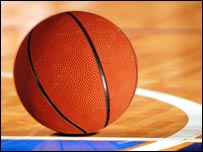 |
Basketball is played by two teams who score points by throwing a ball into the opposing team's basket. The team who scores the most points are the winners.
Each team has a squad of 12 players to choose from. Five of those players are allowed on the court at any one time, with unlimited substitutions.
Players can move the ball around the court by passing, tapping, throwing, rolling or dribbling.
DURATION
The game consists of four quarters of 10 minutes each, with a 15-minute break at half-time.
There is also two-minute interval between the first and second periods, and between the third and fourth periods.
If the game is tied after the fourth period, it continues with an extra period of five minutes, then as many five-minute periods as are necessary to break the tie.
OFFICIALS & STARTING THE GAME
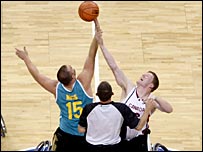 Every game starts with a tip-off |
The main officials include one referee and one umpire.
The court is divided between them and they swap places after each foul involving a free throw penalty, as well as after each jump ball decision.
They use whistles and hand signals to make and explain their decisions.
Each game begins with a jump ball or tip-off.
The referee throws the ball into the air in the centre circle and two opposing players leap up and try to tap it away.
Each player is allowed two taps before the ball hits the ground, a basket, a backboard or another player.
SCORING
Points are scored for shooting the basketball through the hoop.
Two points for a goal inside the three-point semi-circle, and three points for goals scored from outside.
Free throws, taken from the free-throw line and awarded after a foul, are worth one point.
Basketball scoring
How points are scored in a basketball game:
OUTSIDE THE THREE-POINT LINE
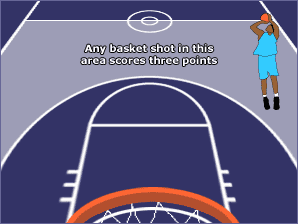
Shots scored from outside of the three-point line - the D-shaped arc surrounding each team's basket - earn three points.
The shooter must have at least one foot on the floor outside the three-point line prior to the attempt.
Three-point shooting is highly prized by teams and spectators alike, especially if the winning basketball is hit from distance on the buzzer.
INSIDE THE THREE-POINT LINE

Shots which find the basket from inside of the three-point line are worth two points.
An unsuccessful free throw attempt which is tapped into the basket also counts as two points.
FREE THROWS
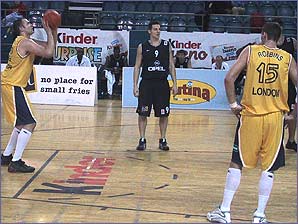
A Free throw is an unchallenged shot at the basket from the free-throw line, taken while the clock is stopped.
They are worth one point.
They are awarded after a technical foul, or a personal foul on a player in the act of shooting. The number awarded (1-3) depends on the offence.
If a player scores despite being fouled, he also gets free throws.
Basketball: time restrictions
24-SECOND RULE
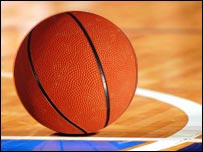 |
There are a number of time restrictions that dictate how long a team or player has to make a particular move.
After a team gains possession of the ball, they have 24 seconds - timed by a "shot clock" - to shoot.
Possession is handed to the other team if they fail to do so.
EIGHT-SECOND RULE
After the attacking team gains possession of the ball in their own half, they have eight seconds to move the ball into the opposition's half.
Otherwise they lose possession.
FIVE-SECOND RULE
Throw-ins from the sidelines or free throws must must be taken within five seconds of the re-start.
THREE-SECOND RULE
A player can only be in the opposition's restricted area - or the "key" - for three seconds.
A violation will be called if the player does not leave in time.
TIME OUTS
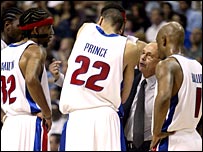 |
Play can be stopped for coaches to discuss tactics and game plans with their players.
Each team can call one time out in the first three quarters and two in the last, each lasting for a maximum of 60 seconds.
Only one per team is available in overtime regardless of its duration.
Basketball: personal fouls
There are the eight personal foul offences.
|
A personal foul results in either player taking free throws or a team surrendering possession.
HOLDING: When personal contact is made with an opponent which restricts their movement.
ILLEGAL GUARDING: Where a defending player makes contact with an opponent from behind.
BLOCKING: Any sort of contact between two players where an opponent's movements are impeded.
PUSHING: Called when a player moves or attempts to move an opponent with force, even if they do not have control of the ball.
ILLEGAL SCREENING: An attempt to slow down or stop an opponent who does not have control of the ball.
HAND CHECKING: When a defending player uses their hands on an opponent to slow their progress.
CHARGING: When a player, with or without the ball, pushes or moves into an opponent.
ILLEGAL USE OF HANDS: When contact is made by a player's hand on an opponent when they are attempting to play the ball.
Basketball: miscellaneous fouls
Fouls in basketball not covered by the personal category are as follows:
TECHNICAL: Covers such things as bad language and other unsportsmanlike conduct.
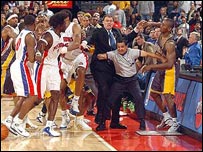 |
DISQUALIFYING: Called if a player commits a serious foul, such as striking an opponent. They will be dismissed immediately from the game.
FIVE-FOUL: If a player commits five fouls, either personal or technical, they must leave the game and cannot return. They can be replaced by a substitute.
TEAM FOUL: Each personal foul committed by a player is also counted against his team; when a team goes over the limit, its opponent is awarded a free-throw.
In America's NBA, the limit is five fouls - personal or technical - in any one period, after which the opposing team get two free throws.
VIOLATION: Covers such things as an illegal dribble or spending more than three seconds in the restricted area. Possession is handed to the opposition, usually via a throw-in.
Basketball: playing positions
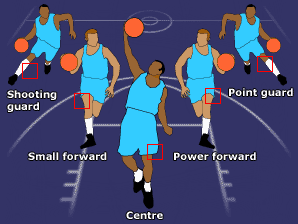
There are five main positions on the court: shooting guard, small forward, centre, power forward, and point guard.
But it is every player's responsibility to try and stop the opposition from scoring.
And every player can push forward to try and make that all-important basket.
Different players will possess a variety of skills.
Depending on how well the team are getting on, the coach will want different players with certain jobs on the court at any one time.
A team can have no more than 12 players, and can make unlimited substitute changes.
Any team member in the squad is regarded as a substitute when they are not playing.
No player can re-enter the game after they have been ejected.
A team's primary reserve or back-up player is known as the "sixth man".
